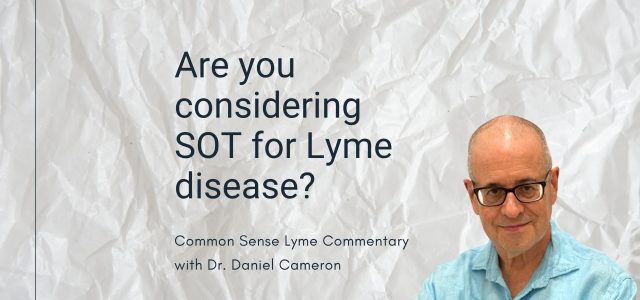
“What do you think about SOT?”
She looked at me earnestly. She had already been through two rounds of antibiotics, herbal protocols, and a year of chronic symptoms.
“I know it’s expensive, but people are saying it helps. Should I try it?”
It wasn’t the first time I’d been asked.
Patients often come to me with questions about experimental or emerging therapies—especially after exhausting standard treatments for Lyme disease. One that’s been generating buzz lately is Supportive Oligonucleotide Therapy (SOT).
Some say it changed their lives. Others say it did nothing—or even made them worse. So what exactly is SOT, and what does the science say?
What Is SOT Therapy?
Supportive Oligonucleotide Therapy involves a lab-designed oligonucleotide—essentially a short strand of synthetic genetic material—that binds to a specific RNA or DNA sequence of a targeted microbe. In the case of Lyme disease, the goal is to inhibit the expression of bacterial genes essential for Borrelia’s survival, ideally leading to its destruction.
This therapy was originally developed in oncology settings, but has since been adapted for infections like Borrelia burgdorferi, Epstein–Barr virus (EBV), and Herpes Simplex Virus (HSV). It’s administered intravenously and customized for each patient based on PCR testing.
Unlike antibiotics, SOT is designed to act more selectively—without directly targeting the bacterial cell wall or metabolism.
Preliminary Evidence: What One Study Found
Apostolou and colleagues published a small exploratory study titled *“Supportive Oligonucleotide Therapy (SOT) as a Potential Treatment for Viral Infections and Lyme Disease: Preliminary Results.”*¹ They analyzed the effect of SOT on 115 patients, including a subset with Lyme disease.
-
For Lyme disease patients, SOT targeted the outer surface proteins OspA and OspB—markers found on Borrelia burgdorferi.
-
The authors reported a statistically significant drop in DNA copy numbers after one or two SOT treatments.
-
Their conclusion: “SOT might be beneficial for patients with Lyme disease or infections by viruses such as EBV and HSV.”
However, the study had important limitations:
-
It did not assess clinical symptoms, so it remains unclear whether the drop in DNA correlated with patient improvement.
-
The study did not evaluate safety or potential adverse effects.
-
It also did not address co-infections or overlapping conditions, which are common in patients with chronic illness.
-
The effect of biofilms or persister forms of Borrelia—known treatment challenges—was not explored.
Additionally, the SOT used in the study was manufactured by RGCC Labs in Greece, a facility not regulated by the U.S. FDA. The therapy is currently offered at a small number of clinics, typically out-of-pocket.
Do I Prescribe SOT in My Practice?
At this time, I do not prescribe Supportive Oligonucleotide Therapy (SOT) in my practice.
Many patients are understandably drawn to new therapies, especially when they’ve tried so much without lasting relief. While I remain open to emerging options, I also believe it’s important to ground decisions in what we know—balancing openness with caution, and always considering the unique details of each patient’s case.
Right now, there is not enough peer-reviewed research or clinical outcome data for me to confidently recommend SOT as part of a standard treatment plan. I continue to monitor the evolving science closely and remain open to promising approaches as more evidence becomes available.
In the meantime, I focus on care supported by both research and clinical experience—tailoring my approach to each individual to address persistent infection, immune dysregulation, inflammation, and the emotional toll of long-term illness.
What I Tell My Patients About SOT
When patients ask about SOT, I start by looking at the full picture of where they are in their journey.
Have all the possible causes of their symptoms been explored? Are there still unanswered questions or overlooked clues? Have we taken the time to fully understand what’s driving the illness?
Sometimes, patients are searching for the next step—but what they really need is a closer look at the foundation. In many cases, we don’t need to go further. We need to go deeper.
Bottom Line
Supportive Oligonucleotide Therapy may offer a novel strategy to address chronic infections, including Lyme disease. But at this stage, it’s important to recognize:
-
Research is limited. Only one small study has evaluated SOT for Lyme, and it focused on PCR results—not symptom improvement.
-
Safety has not been rigorously studied, especially in patients with complex, multi-system illness.
-
It is not a replacement for a thorough clinical evaluation and thoughtful treatment plan.
SOT might have a place in Lyme care down the road—but for now, it should be viewed as experimental, not established. If you’re considering it, speak with a clinician who understands the full picture—including Lyme, co-infections, immune disruption, and other possible diagnoses—so you can make the most informed decision possible.
¹ Apostolou P, Iliopoulos A, Beis G, Papasotiriou I. Supportive Oligonucleotide Therapy (SOT) as a Potential Treatment for Viral Infections and Lyme Disease: Preliminary Results. Infect Dis Rep. 2022;14(6):824–836. doi:10.3390/idr14060084



Are Serrapeptase, Natokinase, NAC useful in treatment? Any contradictions?
I have left that question up to the integrative medicine doctors who have more experience. I have not seen any contraindications.
I really enjoy these posts. Please keep them coming.
Will do
I did SOT. I believe it may be potentially dangerous. There’s very little info on how the mRNA is delivered, but one article I read written by the founder of RGCC himself mentions lipid nanoparticles as the delivery method. Having heard so much negative info on the LNP’s I wish I hadn’t done the SOT.
My body immediately rejected the SOT as it was going into my vein, in the form of an allergic reaction. Instead of stopping the infusion, they encouraged me to power through it and take a lot of oral quercetin. Again, I’m still shocked when I think about it, now that I know more about mRNA and lipid nanoparticles.
Bottom line, there’s a lot they (RGCC) don’t tell you about the SOT and I wish I had read this article before having mine (which was back in 2021). Thanks for this article.
I just heard about this therapy in Instagram, immediately I started to google it. Seems tricky
I just heard about this therapy in Instagram, immediately I started to google it. I found this post, thanks for sharing the information!
SOT is saving my kid…one infusion at a time. Eight years of conventional medicine and misdiagnoses almost killed him. It’s sad that we don’t have the funding to do more research. It’s not a big pharma approach, so it will never be at the top of the list, despite Lyme being endemic in many areas. Such a broken medical system.